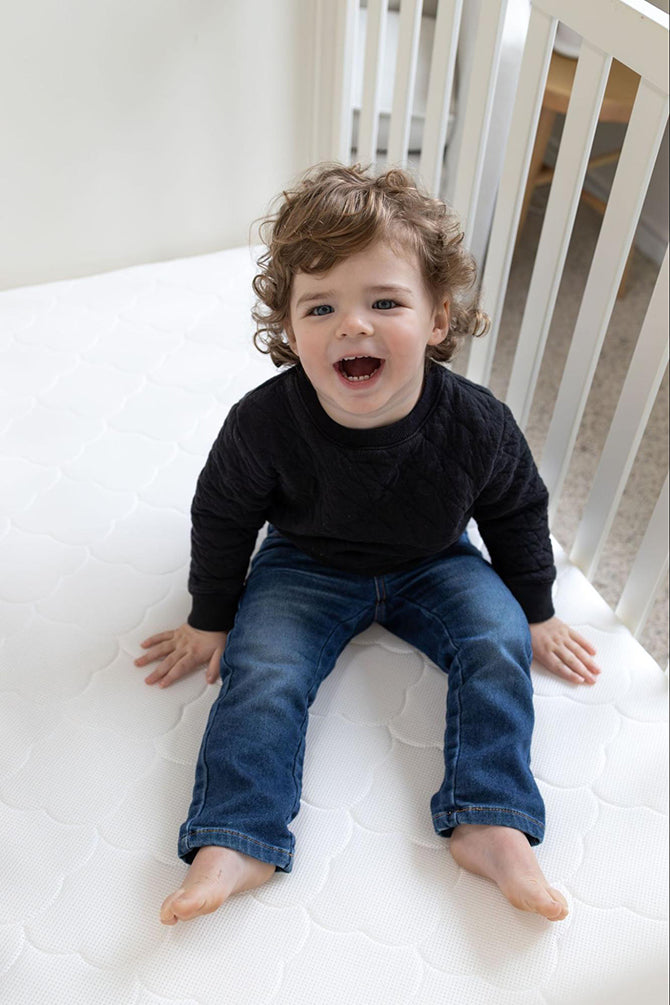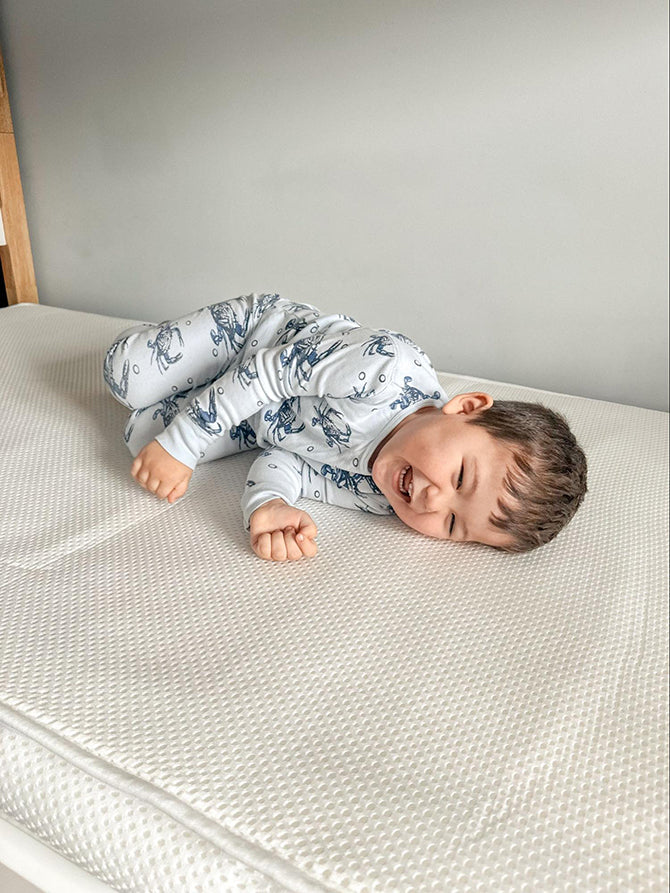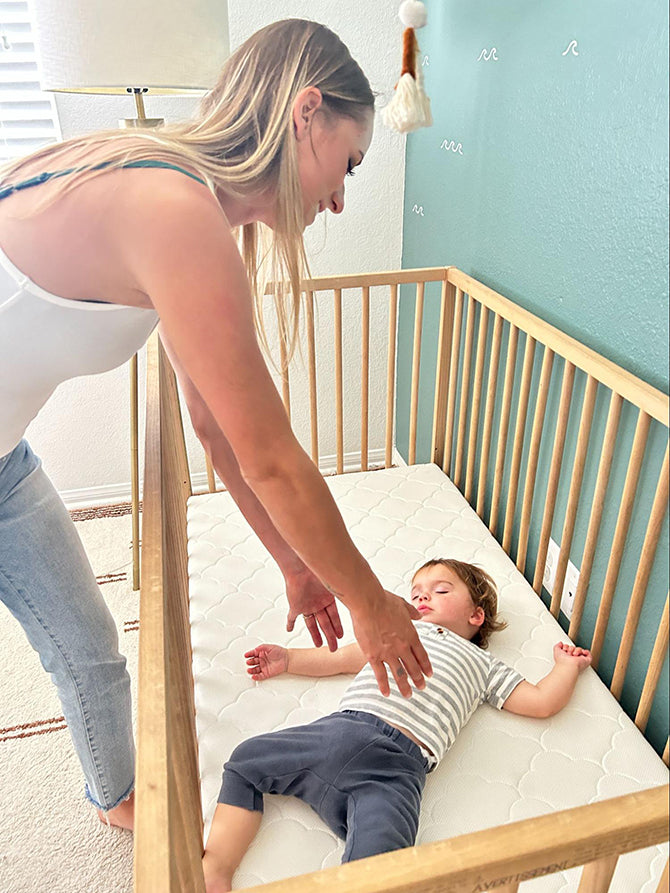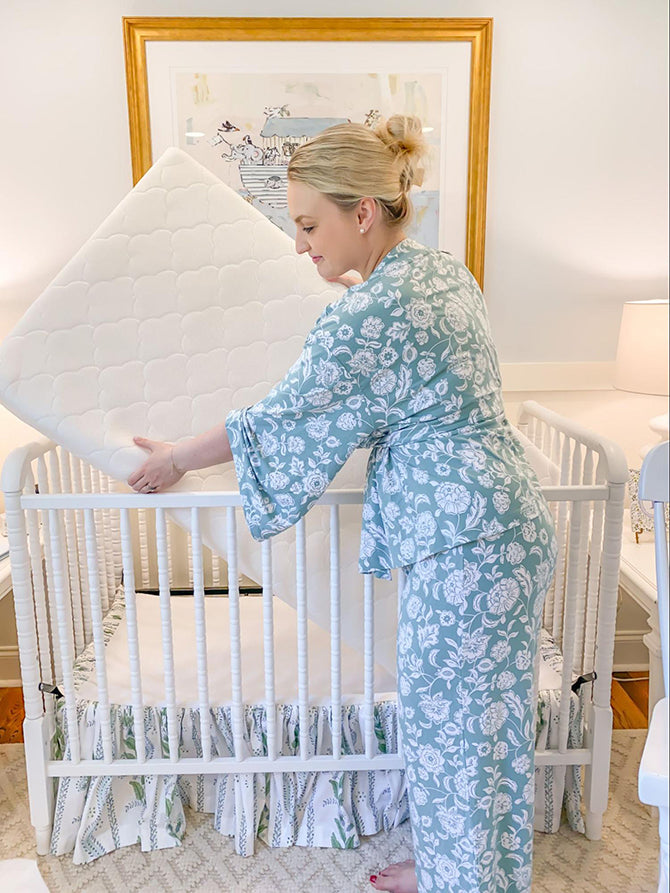
Just when you find a consistent sleep routine for your baby, it changes. After establishing everything you needed to provide a healthy nap schedule for your little one, you realize now you need to figure out when to transition to one nap.
Consider this article your personal guide to handling when and how to switch your baby from two naps to one.
Table of contents
- When to transition to one nap: Age
- When to transition to one nap: Signs
- How to know it’s too soon to drop a nap
- Things that can be confused with readiness to drop a nap
- Tips for a smooth transition into one nap
- How to help your baby get their needed rest
- Safe sleep for babies and toddlers
When to transition to one nap: Age

Most children are ready to fully transition from two naps to one nap around 14-18 months old. Once a nap is dropped, they will need to be able to comfortably stay awake for at least five hours before and after their one remaining nap.
For babies younger than 12 months, it is rarely time to drop to one nap. But if you do see signs that they are ready at this age, start by shortening their morning nap to see if this helps resolve any issues.
Tweaking your child's schedule can solve most problems. For example, if they take a long morning nap and then melt down in the afternoon, try ending their morning siesta to make them more cooperative for the second one.
You can also try waking them up early from their morning nap. However, don't cut any nap to under 45 minutes. Your child needs that much time to complete a full sleep cycle.
Making the transition before your child is ready can lead to miserable days and cause night-time awakenings. It can take them longer to adjust. And as you may have experienced, overtired kids and babies tend to sleep worse than well-rested ones.
Ultimately, a successful transition depends on the readiness of the child.
Which nap should I drop?
Some babies can successfully make the transition from their morning nap, while others will sleep better when the second nap is eliminated.
As your baby’s wake windows lengthen, they will need more awake time before each sleep period. This means that the first nap is shifted later into the day, and the second nap is eliminated. The one remaining nap should be in the middle of the day.
As mentioned above, there should be about five hours on either side of the nap. It’s common for the nap to be short at first and then eventually lengthen to two to three hours long.
For more clarity, below is an example of a 14-month-old nap schedule. Remember that every child is different, and this is only an example:
- Morning rise: 7:00 a.m.
- Nap: 11:45 a.m. to 2:00 p.m.
- Get ready for bed: 6:45 p.m.
- Asleep: 7:15 p.m.
Notice that the nap is 2.25 hours long, and there were 4.75 hours of awake time before it. In addition, there were 5.25 hours of awake time before bedtime.
When to transition to one nap: Signs
Luckily, some telltale signs will guide you in deciding when to transition to one nap. Look out for these common signs that your baby is ready to conquer one nap a day:
- They are resistant to both naps
- Your little one requires a late bedtime in order to fit both naps into the day
- They play, fuss, or take a short nap when you put them down
- Your child sleeps well for the first nap and resists the second
- You notice your child is happy or energetic when they miss one nap
- They don’t fall asleep during early car rides
- They wake up early or frequently in the middle of the night
Important note: don’t just drop a nap the minute you see one of these signs. You want to look at two weeks of sleep patterns to decide if it’s the right time. If your little one is consistently skipping at least four naps a week, they might be ready to make the change.
How to know it’s too soon to drop a nap

You may have decided the time was right to transition to one nap but then noticed some signs concerning signs in your little one. These might include:
- Getting really sleepy or cranky around the time of the dropped nap
- Not waking their usual morning hour
- Having more meltdowns
- Being hyperactive and overtired
- Trouble concentrating
If any of these signs sound familiar, revert to two naps a day and try again in a couple of months.
Things that can be confused with readiness to drop a nap
There are reasons besides being ready to drop a nap that your little one might do some of the things we mentioned earlier. One possibility is that they could be experiencing sleep regression.
Sleep regression is when a baby is sleeping well for months but all of a sudden starts having trouble again — either refusing to nap or getting up in the middle of the night.
One way to tell the difference is that sleep regressions are temporary, typically lasting between two and six weeks. They most often happen at the following ages:
The regressions that might be mistaken for readiness to transition to one nap a day will likely be the 12-month, 18-month, and 2-year regressions. Let’s take a closer look at these:
12-month sleep regression
At 12 months old, your baby may experience a sleep regression for lots of reasons.
At this age, your little one is walking and talking — two big milestones that result in increased mobility and socialization. That excitement is sure to affect their shuteye.
Separation anxiety and teething pain are also possible triggers of regression for children of this age.
18-month sleep regression
At 18 months, their trouble sleeping may be caused by their increasing vocabulary, or gain in independence. Again, teething is another reason for their disrupted sleep.
2-year sleep regression

At two years old your toddler is doing all sorts of things, like running, jumping, climbing, throwing, and catching. They’re also getting creative and engaging in pretend play. All of these activities can result in a regression that interferes with their ability to nap and sleep.
Of course, the above examples are not exhaustive. Any physical, emotional, or social changes can trigger these sleepless bouts. Other common causes include:
- Illness
- Travel
- Changes in routine
- Discomfort
- A new sibling
- Change in babysitter
- Improper sleep environment
- Nightmares
- Changing to a toddler bed or twin bed
If you think your little one might be rebelling against naptime because of a sleep regression, keep offering their regular naps until the regression passes.
Medical issues
In rare instances, your little one could be having trouble sleeping because of a medical issue such as sleep apnea. If this is a concern, get peace of mind by visiting your pediatrician.
Tips for a smooth transition to one nap
Just like anything else with your growing baby, there is no one-size-fits-all. There is always trial and error until you find a successful solution. You may experience some hiccups for a little bit, but this is temporary and normal.
In the meantime, here are some tips to ease the transition.
1) Consider going cold turkey in some situations.

In considering when to transition to one nap, dropping one cold turkey may sound severe. But some children can handle an immediate adjustment to a one-nap schedule when the morning nap moves to the middle of the day and bedtime is earlier.
This strategy is better for children who are already awake four or more hours between their morning awake time and their first nap and are showing consistent signs that the two-nap schedule is no longer working well for them.
2) Try a gradual transition.
Alternatively, you can make nap changes gradually. This gradual transition can work better for toddlers on the younger side who are showing signs they are ready to drop a nap. A gradual transition also works for children who get easily overtired.
Every few days, start by moving the first nap later by 15 minutes. While your baby’s first nap is still before the afternoon, you may need to offer a second shorter nap in order to get them to bedtime without becoming overtired.
As naps move later into the day, your baby's bedtime may temporarily shorten. But after your little one fully transitions into a one-nap schedule, bedtime sleep should lengthen again.
Once your baby’s first nap takes place in the afternoon, you can officially move it to five hours after they wake up in the morning and phase out the second nap.
If this shorter nap process doesn’t work, try putting your baby down for an early bedtime, but no earlier than 6:00 p.m.
3) Provide a wind-down routine.

You may already be a pro at bedtime routines to prepare your baby for a good night’s sleep, so why not start a naptime routine that will set your little one up for a restorative nap?
A naptime routine doesn’t have to be complicated. Just set aside seven to 10 minutes for your little one to decompress before a nap.
Here is an example of a short and sweet naptime routine:
- Change baby’s diaper
- Put them in comfortable clothing like a sleep sack or PJs
- Read them a book
- Shut off or dim the lights
- Place them into their crib awake
All of these cues let your little one know that sleep is on its way!
4) Alternate between 1- and 2-nap schedules.
During the nap transition, a toddler can comfortably handle a few consecutive days with just one nap. But at first, they may become overtired, which can lead to sleep difficulties.
To combat overtiredness, you can flip-flop between one-nap days and two-nap days as your child gets used to staying awake for longer periods of time.
Offering two naps every few days can help “reset” the sleep pressure that will build up as they adjust. On days with no second nap, continue to offer an earlier bedtime.
Alternating nap schedules is a good option if your baby is being transitioned to a one-nap schedule at daycare before they’re ready or they seem to be getting overtired from the nap transition.
You might find that on some days your child will need one nap, and on other days, they will need two. It’s perfectly normal. Every child transitions on their own readiness.
5) Consider when to transition to one nap at daycare.

If your little one is in daycare, naptime may be out of your control. That’s OK. Trust your daycare workers and know you still have control over bedtime.
However, it’s important to communicate with the daycare staff and come up with a plan. You may even be able to move your child to a different room during nap time.
If not, don’t worry too much. A lot of children go to daycare and do perfectly fine, even with one sleeping pattern during the week and a contrasting one on weekends. Eventually, their nap schedules will sync, and you won't need to worry about their napping routine anymore.
6) Add in quiet time.
Designate the time that your little one used to nap as quiet time. You can put on some soothing music, read, or enjoy a quiet activity together.
7) Be ready for some bumps in the road.
Transitioning to one nap a day can take time. You want to be ready to deal with some crankiness along the way. Try to show your little one that you understand their emotions and that you care.
If the crankiness persists and they seem tired during the day, as we mentioned, consider going back to two naps for a month or two before trying again.
8) Stay consistent.
As a parent, you’ve probably learned that consistency is key, especially with sleep time. Consistency is important as you help shift your baby’s sleep and nap routine.
Transitioning to one nap can often take two to four weeks, so be patient and stay the course!
How to help your baby get their needed rest

Helping your baby or toddler get enough rest at naptime and bedtime is a matter of setting yourself (and your baby) up for success and following a good routine.
If you’ve decided that this is when to transition to one nap, you’ll want your little one to get the best sleep possible. Here are some tips.
1) Keep their sleep area cool.
First of all, you’ll want to be sure their room is cool yet comfortable. Setting the temperature between 65 and 72 degrees is ideal for sleep.
2) Make it dark.
You’ll also want to invest in blackout curtains to keep the room dark so that when your little one naps during the day, they’re not distracted by too much light.
3) Manage noise levels.
Of course, when your baby is napping or sleeping, you’ll want the house to be quiet. Ideally, everyone has some rest time or focuses on quiet activities.
Even though you can control indoor noise, it’s impossible to predict noises outside. Investing in a sound machine can help drown out any outdoor noise and relax your little one. Be sure to keep it at a low volume.
4) Dress your little one for sleep success.
What your baby wears to bed is also important. They may sleep in a sleep sack or pajamas at one to two years. Make sure the fabric is breathable and comfortable — natural fabrics are best, like Pima cotton or muslin.
You don’t want anything with buttons or embellishments that may be uncomfortable.
5) Consider a humidifier.
If your home is on the dry side, consider adding a humidifier to your child’s room. Moistening the air will help them breathe easily through their nap.
The ideal indoor humidity is between 30% to 50%, and you should never exceed 60%, or else you will risk getting mold or bacteria.
Keep in mind that humidifiers require regular cleaning every couple of days.
6) Try a bath before bed.
If they are having a hard time sleeping, sometimes a bath before bed can help. This lowers the body temperature which is conducive for sleep.
7) Give your toddler a blanket or favorite stuffed animal.
As long as your child is over 12 months old, you can give them a blanket or stuffed animal to sleep with. This familiar friend may make them more relaxed at nap or bedtime.
8) Keep electronics out of the bedroom.
To ensure a good rest, keep devices out of the bedroom. For little ones, even if powered off in their room, a tablet or TV may be too tempting.
9) Spend time outdoors during the day.
Make sure your little one gets outside during the day and enjoys a little sunshine. The fresh air and daylight can help set their circadian rhythm so that their body is ready to rest at bedtime.
Safe sleep for babies and toddlers
When it’s time for your child to get their zzzs, you want to make sure they are as safe as possible.
Many safe sleep guidelines are intended for children under 12 months — like putting them to bed on their back and ensuring that their crib has nothing in it but them, the mattress, and fitted sheet.
But because children normally drop down to one nap a day after 12 months, we’ll just focus on the safety tips to keep in mind for children over one.
Use a firm, breathable mattress.

Although this is an important safety rule for babies, it’s also good for toddlers. A firm, breathable mattress supports growing bones and helps your little one to stay comfortable by maximizing airflow.
Newton Baby’s Essential Crib Mattress is an excellent choice for little nappers, as these are not only firm and breathable, but also washable.
Accidents happen, and when one does, it’s nice to know you can easily clean both the inside and the outside of your child’s mattress quickly and easily — our Extra Original Crib Mattress Cover to the rescue!
Make sure your child’s room is hazard-free.
As your little one is probably still napping and sleeping at night in their crib, you want to think about making sure anything in the crib with them is safe. Some toys have small parts that can pose choking hazards, so be sure that everything with them is age-appropriate.
You don’t want too many toys in the crib, either, as your clever child might try to stack them up and stand on them in order to escape the crib.
Bumpers are no longer allowed these days, so you probably won't have one, but if you do, take it out of the crib to avoid providing easy footholds for curious kids.
Safety isn’t just limited to what’s in the crib. You also want to look around the crib at whatever’s in arm’s reach. Any dangling cords, ties, or ribbons can be a strangulation hazard. Picture frames hung over the crib can also be dangerous and should be out of reach.
You’ll also want to make sure you have anchors on all of your furniture so nothing can tip. Double-check that anything that needs babyproofing (cabinets, electrical outlets, sharp edges) has been addressed.
One nap success

Knowing when to transition to one nap can be a bit challenging at first. Even with the right tools, it’s a big change to introduce to your little one!
Give yourself and your baby lots of grace, and know that we’re always here for you. If you need support, try our Newton Sleep Consultation Powered by Tot Squad.
Before you know it, your baby will be three or four years old with no more naps and a different milestone to tackle. Until then, you’ve got this!

